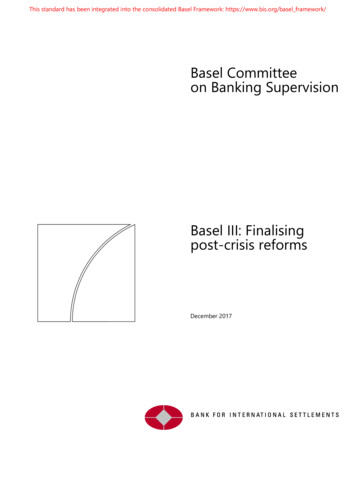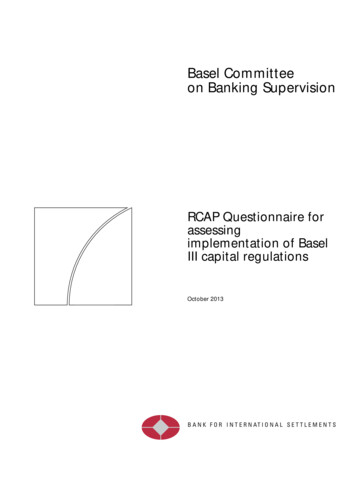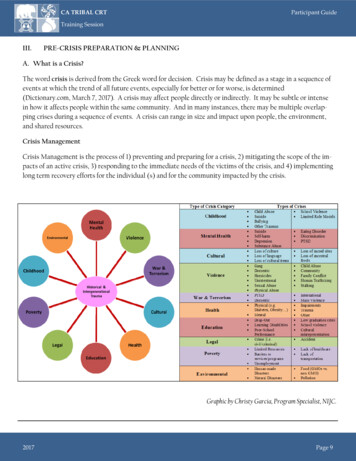
Transcription
This standard has been integrated into the consolidated Basel Framework: https://www.bis.org/basel framework/Basel Committeeon Banking SupervisionBasel III: Finalisingpost-crisis reformsDecember 2017
This publication is available on the BIS website (www.bis.org). Bank for International Settlements 2017. All rights reserved. Brief excerpts may be reproduced ortranslated provided the source is stated.ISBN 978-92-9259-022-2 (online)
ContentsIntroduction . 1Standardised approach for credit risk . 3Internal ratings-based approach for credit risk. 53Minimum capital requirements for CVA risk . 109Minimum capital requirements for operational risk. 128Output floor. 137Leverage ratio . 140Basel III: Finalising post-crisis reformsiii
Introduction1.This document sets out the Basel Committee’s finalisation of the Basel III framework. Itcomplements the initial phase of Basel III reforms previously finalised by the Committee. The Basel IIIframework is a central element of the Basel Committee’s response to the global financial crisis. It addressesa number of shortcomings with the pre-crisis regulatory framework and provides a regulatory foundationfor a resilient banking system that supports the real economy.2.A key objective of the revisions in this document is to reduce excessive variability of risk-weightedassets (RWAs). At the peak of the global financial crises, a wide range of stakeholders – includingacademics, analysts and market participants – lost faith in banks’ reported risk-weighted capital ratios. TheCommittee’s own empirical analyses highlighted a worrying degree of variability in the calculation of RWAsby banks.3.A prudent and credible calculation of RWAs is an integral element of the risk-weighted capitalframework. Banks’ reported risk-weighted capital ratios should be sufficiently transparent and comparableto permit stakeholders to assess their risk profile. The Committee’s strategic review of the regulatoryframework highlighted a number of fault lines with the existing architecture, particularly the extent towhich it adequately balances simplicity, comparability and risk sensitivity.4.The revisions to the regulatory framework set out in this document will help restore credibility inthe calculation of RWAs by: (i) enhancing the robustness and risk sensitivity of the standardisedapproaches for credit risk and operational risk, which will facilitate the comparability of banks’ capitalratios; (ii) constraining the use of internally-modelled approaches; and (iii) complementing the riskweighted capital ratio with a finalised leverage ratio and a revised and robust capital floor. Anaccompanying document summarises the main features of these revisions. 15.In finalising these reforms, the Committee was guided by three overarching principles. First, theCommittee is firmly committed to its mandate of strengthening the regulation, supervision and practicesof banks worldwide, with the purpose of enhancing financial stability. A banking system that is resilientwill be able to support the real economy and contribute positively to sustainable economic growth overthe medium term.6.Second, the Committee actively seeks the views of stakeholders when developing standards. Forthese reforms, the Committee conducted an extensive consultation process with a wide range ofstakeholders. The Committee thanks all stakeholders for their constructive contributions during thisprocess.7.Third, the Committee conducted a comprehensive and rigorous assessment of the impact ofthese revisions on the banking system and the wider macro economy. As a result of this assessment, theCommittee focused on not significantly increasing overall capital requirements. 2 This is reflected in thedesign, calibration and transitional arrangements discussed below. The Committee will continue tomonitor and evaluate the effectiveness of these reforms in reducing excessive RWA variability.8.While the revised framework will continue to permit the use of internally-modelled approachesfor certain risk categories (subject to supervisory approval), a jurisdiction which does not implement someor all of the internal-modelled approaches but instead only implements the standardised approaches iscompliant with the Basel framework. More generally, jurisdictions may elect to implement more1The summary of the main features of the Basel III reforms is available at www.bis.org/bcbs/publ/d424 hlsummary.pdf.2The quantitative impact study is available at www.bis.org/bcbs/publ/d426.htm.Basel III: Finalising post-crisis reforms1
conservative requirements and/or accelerated transitional arrangements, as the Basel frameworkconstitutes minimum standards only.Implementation dates and transitional arrangements9.The Committee is introducing transitional arrangements to implement the new standards toensure an orderly and timely implementation by jurisdictions and adjustment by banks. The mainimplementation dates are provided in the table below.RevisionImplementation dateRevisions to standardised approach for credit risk 1 January 2022Revisions to IRB framework 1 January 2022 3Revisions to CVA framework 1 January 2022Revisions to operational risk framework 1 January 2022 Existing exposure definition: 1 January 2018 4Leverage ratio G-SIB buffer: 1 January 2022 1 January 2022: 50% Output floorRevised exposure definition: 1 January 2022 5 1 January 2023: 55%1 January 2024: 60%1 January 2025: 65%1 January 2026: 70%1 January 2027: 72.5%3On implementation of the revisions to the risk-weighted framework outlined in this standard and the revised output floor, the1.06 scaling factor that applies to the RWA amounts for credit risk under the IRB approach will no longer apply. More specifically,the references to the scaling factor in paragraphs 14 and 44 of the Basel II framework (June 2006), and paragraphs 49, 88, 90and 91 of the revised securitisation framework (July 2016) will no longer apply.4Based on the January 2014 definition of the leverage ratio exposure measure. Jurisdictions are free to apply the reviseddefinition of the exposure measure at an earlier date than 1 January 2022.5Based on the revised leverage ratio exposure measure set out in this document.2Basel III: Finalising post-crisis reforms
Standardised approach for credit riskIntroduction1.The Committee permits banks to choose between two broad methodologies for calculating theirrisk-based capital requirements for credit risk. The first, the standardised approach, assigns standardisedrisk weights to exposures as described in paragraphs 4 to 97. To determine the risk weights in thestandardised approach for certain exposure classes, in jurisdictions that allow the use of external ratingsfor regulatory purposes, banks may, as a starting point, use assessments by external credit assessmentinstitutions that are recognised as eligible for capital purposes by national supervisors, in accordance withparagraphs 98 to 116. Under the standardised approach, exposures should be risk-weighted net of specificprovisions (including partial write-offs).2.The second risk-weighted capital treatment for measuring credit risk, the internal ratings-based(IRB) approach, allows banks to use their internal rating systems for credit risk, subject to the explicitapproval of the bank’s supervisor.3.Securitisation exposures are addressed in the securitisation standard. 1 Credit equivalent amountsof OTC derivatives, exchange traded derivatives and long-settlement transactions that expose a bank tocounterparty credit risk 2 are to be calculated under the counterparty credit risk standards. 3 Equityinvestments in funds and exposures to central counterparties must be treated according to their ownspecific frameworks. 41The securitisation standard is available at www.bis.org/bcbs/publ/d374.pdf.2Counterparty credit risk is defined as the risk that the counterparty to a transaction could default before the final settlement ofthe transaction’s cash flows. An economic loss would occur if the transactions or portfolio of transactions with the counterpartyhas a positive economic value at the time of default. Unlike a firm’s exposure to credit risk through a loan, where the exposureto credit risk is unilateral and only the lending bank faces the risk of loss, counterparty credit risk creates a bilateral risk of loss:the market value of the transaction can be positive or negative to either counterparty to the transaction. The market value isuncertain and can vary over time with the movement of underlying market factors.3The counterparty credit risk standards are set out in Annex 4 of the Basel II framework (June 2006), amended to reflect thechanges set out in: (i) Basel III: A global regulatory framework for more resilient banks and banking systems (June 2011), availableat www.bis.org/publ/bcbs189.pdf; (ii) The standardised approach for measuring counterparty credit risk exposures (April 2014),available at www.bis.org/publ/bcbs279.pdf; and (iii) Capital requirements for bank exposures to central counterparties (April2014), available at www.bis.org/publ/bcbs282.pdf.4Standards on capital requirements for banks’ equity investments in funds are available at www.bis.org/publ/bcbs266.pdf; andfor capital requirements for bank exposures to central counterparties are set out in Section XI of the counterparty credit riskstandards.Basel III: Finalising post-crisis reforms3
A.Individual exposuresDue diligence requirements4.Consistent with the Committee’s guidance on the assessment of credit risk 5 and paragraphs 733to 735 of the Basel II framework (June 2006), banks must perform due diligence to ensure that they havean adequate understanding, at origination and thereafter on a regular basis (at least annually), of the riskprofile and characteristics of their counterparties. In cases where ratings are used, due diligence isnecessary to assess the risk of the exposure for risk management purposes and whether the risk weightapplied is appropriate and prudent. 6 The sophistication of the due diligence should be appropriate to thesize and complexity of banks’ activities. Banks must take reasonable and adequate steps to assess theoperating and financial performance levels and trends through internal credit analysis and/or otheranalytics outsourced to a third party, as appropriate for each counterparty. Banks must be able to accessinformation about their counterparties on a regular basis to complete due diligence analyses.5.For exposures to entities belonging to consolidated groups, due diligence should, to the extentpossible, be performed at the solo entity level to which there is a credit exposure. In evaluating therepayment capacity of the solo entity, banks are expected to take into account the support of the groupand the potential for it to be adversely impacted by problems in the group.6.Banks should have in place effective internal policies, processes, systems and controls to ensurethat the appropriate risk weights are assigned to counterparties. Banks must be able to demonstrate totheir supervisors that their due diligence analyses are appropriate. As part of their supervisory review,supervisors should ensure that banks have appropriately performed their due diligence analyses, andshould take supervisory measures where these have not been done.1.Exposures to sovereigns(Treatment unchanged from the Basel II framework (June 2006))7.Exposures to sovereigns and their central banks will be risk-weighted as follows:Risk weight table for sovereigns and central banksExternal ratingRisk weightAAA to AA–0%Table 1A to A–BBB to BBB–BB to B–Below B–Unrated20%50%100%150%100%5Basel Committee on Banking Supervision, Guidance on credit risk and accounting for expected credit losses, December 2015,available at www.bis.org/bcbs/publ/d350.pdf.6The due diligence requirements do not apply to the exposures set out in paragraphs 7 to 12.4Basel III: Finalising post-crisis reforms
8.At national discretion, a lower risk weight may be applied to banks’ exposures to their sovereign(or central bank) of incorporation denominated in domestic currency and funded 7 in that currency. 8 Wherethis discretion is exercised, other national supervisors may also permit their banks to apply the same riskweight to domestic currency exposures to this sovereign (or central bank) funded in that currency.9.For the purpose of risk-weighting exposures to sovereigns, supervisors may recognise thecountry risk scores assigned by Export Credit Agencies (ECAs). To qualify, an ECA must publish its riskscores and subscribe to the OECD-agreed methodology. Banks may choose to use the risk scorespublished by individual ECAs that are recognised by their supervisor, or the consensus risk scores of ECAsparticipating in the “Arrangement on Officially Supported Export Credits”. 9 The OECD-agreedmethodology establishes eight risk score categories associated with minimum export insurance premiums.These ECA risk scores will correspond to risk weight categories as detailed below.Risk weight table for sovereigns and central banksECA risk scoresRisk weight0 to 10%Table 2234 to 6720%50%100%150%10.Exposures to the Bank for International Settlements, the International Monetary Fund, theEuropean Central Bank, the European Union, the European Stability Mechanism (ESM) and the EuropeanFinancial Stability Facility (EFSF) may receive a 0% risk weight.2.Exposures to non-central government public sector entities (PSEs)(Treatment unchanged from the Basel II framework (June 2006), only minor editorial changes have beenmade to remove reference to current options for banks.)11.Exposures to domestic PSEs will be risk-weighted at national discretion, according to either ofthe following two options.Risk weight table for PSEsOption 1: Based on external rating of sovereignExternal rating of the sovereignRisk weight under Option 1Table 3AAA to AA–A to A–BBB to BBB–BB to B–Below B–Unrated20%50%100%100%150%100%7This is to say that the bank would also have corresponding liabilities denominated in the domestic currency.8This lower risk weight may be extended to the risk-weighting of collateral and guarantees under the CRM framework.9The consensus country risk classification is available on the OECD’s website (www.oecd.org) in the Export Credit Arrangementwebpage of the Trade Directorate.Basel III: Finalising post-crisis reforms5
Risk weight table for PSEsOption 2: Based on external rating of PSEExternal rating of the PSERisk weight under Option 2Table 4AAA to AA–A to A–BBB to BBB–BB to B–Below B–Unrated20%50%50%100%150%50%12.Subject to national discretion, exposures to certain domestic PSEs 10 may also be treated asexposures to the sovereigns in whose jurisdictions the PSEs are established. Where this discretion isexercised, other national supervisors may allow their banks to risk-weight exposures to such PSEs in thesame manner.3.Exposures to multilateral development banks (MDBs)13.For the purposes of calculating capital requirements, a Multilateral Development Bank (MDB) isan institution, created by a group of countries that provides financing and professional advice foreconomic and social development projects. MDBs have large sovereign memberships and may includeboth developed countries and/or developing countries. Each MDB has its own independent legal andoperational status, but with a similar mandate and a considerable number of joint owners.14.A 0% risk weight will be applied to exposures to MDBs that fulfil to the Committee’s satisfactionthe eligibility criteria provided below. 11 The Committee will continue to evaluate eligibility on a case-bycase basis. The eligibility criteria for MDBs risk-weighted at 0% are:(i)10very high-quality long-term issuer ratings, ie a majority of an MDB’s external ratings must beAAA; 12The following examples outline how PSEs might be categorised when focusing on one specific feature, namely revenue-raisingpowers. However, there may be other ways of determining the different treatments applicable to different types of PSEs, forinstance by focusing on the extent of guarantees provided by the central government:-Regional governments and local authorities could qualify for the same treatment as claims on their sovereign or centralgovernment if these governments and local authorities have specific revenue-raising powers and have specific institutionalarrangements the effect of which is to reduce their risk of default.-Administrative bodies responsible to central governments, regional governments or to local authorities and other noncommercial undertakings owned by the governments or local authorities may not warrant the same treatment as claimson their sovereign if the entities do not have revenue-raising powers or other arrangements as described above. If strictlending rules apply to these entities and a declaration of bankruptcy is not possible because of their special public status,it may be appropriate to treat these claims according to Option 1 or 2 for PSEs.-Commercial undertakings owned by central governments, regional governments or by local authorities may be treated asnormal commercial enterprises. However, if these entities function as a corporate in competitive markets even though thestate, a regional authority or a local authority is the major shareholder of these entities, supervisors should decide toconsider them as corporates and therefore attach to them the applicable risk weights.11MDBs currently eligible for a 0% risk weight are: the World Bank Group comprising the International Bank for Reconstructionand Development (IBRD), the International Finance Corporation (IFC), the Multilateral Investment Guarantee Agency (MIGA)and the International Development Association (IDA), the Asian Development Bank (ADB), the African Development Bank(AfDB), the European Bank for Reconstruction and Development (EBRD), the Inter-American Development Bank (IADB), theEuropean Investment Bank (EIB), the European Investment Fund (EIF), the Nordic Investment Bank (NIB), the CaribbeanDevelopment Bank (CDB), the Islamic Development Bank (IDB), the Council of Europe Development Bank (CEDB), theInternational Finance Facility for Immunization (IFFIm), and the Asian Infrastructure Investment Bank (AIIB).12MDBs that request to be added to the list of MDBs eligible for a 0% risk weight must comply with the AAA rating criterion atthe time of the application. Once included in the list of eligible MDBs, the rating may be downgraded, but in no case lowerthan AA–. Otherwise, exposures to such MDBs will be subject to the treatment set out in paragraph 15.6Basel III: Finalising post-crisis reforms
(ii)either the shareholder structure comprises a significant proportion of sovereigns with long-termissuer external ratings of AA– or better, or the majority of the MDB’s fund-raising is in the formof paid-in equity/capital and there is little or no leverage;(iii)strong shareholder support demonstrated by the amount of paid-in capital contributed by theshareholders; the amount of further capital the MDBs have the right to call, if required, to repaytheir liabilities; and continued capital contributions and new pledges from sovereignshareholders;(iv)adequate level of capital and liquidity (a case-by-case approach is necessary in order to assesswhether each MDB’s capital and liquidity are adequate); and,(v)strict statutory lending requirements and conservative financial policies, which would includeamong other conditions a structured approval process, internal creditworthiness and riskconcentration limits (per country, sector, and individual exposure and credit category), largeexposures approval by the board or a committee of the board, fixed repayment schedules,effective monitoring of use of proceeds, status review process, and rigorous assessment of riskand provisioning to loan loss reserve.15.For exposures to all other MDBs, banks incorporated in jurisdictions that allow the use of externalratings for regulatory purposes will assign to their MDB exposures the corresponding “base” risk weightsdetermined by the external ratings according to Table 5. Banks incorporated in jurisdictions that do notallow external ratings for regulatory purposes will risk-weight such exposures at 50%.Risk weight table for MDB exposuresExternal rating of counterpartyAAA to AA–A to A–BBB to BBB–BB to B–Below B–Unrated20%30%50%100%150%50%“Base” risk weight4.Table 5Exposures to banks16.For the purposes of calculating capital requirements, a bank exposure is defined as a claim(including loans and senior debt instruments, unless considered as subordinated debt for the purposes ofparagraph 53) on any financial institution that is licensed to take deposits from the public and is subjectto appropriate prudential standards and level of supervision. 13 The treatment associated withsubordinated bank debt and equities is addressed in paragraphs 49 to 53.Risk weight determination17.Bank exposures will be risk-weighted based on the following hierarchy: 1413For internationally active banks, appropriate prudential standards (eg capital and liquidity requirements) and level ofsupervision should be in accordance with the Basel framework. For domestic banks, appropriate prudential standards aredetermined by the national supervisors but should include at least a minimum regulatory capital requirement.14With the exception of exposures giving rise to Common Equity Tier 1, Additional Tier 1 and Tier 2 items, national supervisorsmay allow banks belonging to the same institutional protection scheme (such as mutual, cooperatives or savings institutions)Basel III: Finalising post-crisis reforms7
(a)External Credit Risk Assessment Approach (ECRA): This approach is for banks incorporated injurisdictions that allow the use of external ratings for regulatory purposes. It applies to all theirexposures to banks that are rated. Banks will apply paragraphs 98 to 116 to determine whichrating can be used and for which exposures.(b)Standardised Credit Risk Assessment Approach (SCRA): This approach is for all exposures ofbanks incorporated in jurisdictions that do not allow the use of external ratings for regulatorypurposes. For exposures to banks that are unrated, this approach also applies to banksincorporated in jurisdictions that allow the use of external ratings for regulatory purposes.(a)External Credit Risk Assessment Approach (ECRA)18.Banks incorporated in jurisdictions that allow the use of external ratings for regulatory purposeswill assign to their rated bank exposures 15 the corresponding “base” risk weights determined by theexternal ratings according to Table 6. Such ratings must not incorporate assumptions of implicitgovernment support, unless the rating refers to a public bank owned by its government. 16 Banksincorporated in jurisdictions that allow the use of external ratings for regulatory purposes must only applySCRA for their unrated bank exposures, in accordance with paragraph 21.Risk weight table for bank exposuresExternal Credit Risk Assessment ApproachExternal rating of counterpartyTable 6AAA to AA–A to A–BBB to BBB–BB to B–Below B–“Base” risk weight20%30%50%100%150%Risk weight for short-term exposures20%20%20%50%150%19.Exposures to banks with an original maturity of three months or less, as well as exposures tobanks that arise from the movement of goods across national borders with an original maturity of sixmonths or less 17 can be assigned a risk weight that correspond to the risk weights for short term exposuresin Table 6.in their jurisdictions to apply a lower risk weight than that indicated by the ECRA and SCRA to their intra-group or in-networkexposures provided that both counterparties to the exposures are members of the same effective institutional protectionscheme that is a contractual or statutory arrangement set up to protect those institutions and seeks to ensure their liquidityand solvency to avoid bankruptcy.15An exposure is rated from the perspective of a bank if the exposure is rated by a recognised “eligible credit assessmentinstitution” (ECAI) which has been nominated by the bank (ie the bank has informed its supervisor of its intention to use theratings of such ECAI for regulatory purposes in a consistent manner (paragraphs 103). In other words, if an external rating existsbut the credit rating agency is not a recognised ECAI by the national supervisor, or the rating has been issued by an ECAI whichhas not been nominated by the bank, the exposure would be considered as being unrated from the perspective of the bank.16Implicit government support refers to the notion that the government would act to prevent bank creditors from incurring lossesin the event of a bank default or bank distress. National supervisors may continue to allow banks to use external ratings whichincorporate assumptions of implicit government support for up to a period of five years, from the date of implementation ofthis standard, when assigning the “base” risk weights in Table 6 to their bank exposures.17This may include on-balance sheet exposures such as loans and off-balance sheet exposures such as self-liquidating traderelated contingent items.8Basel III: Finalising post-crisis reforms
20.Banks must perform due diligence to ensure that the external ratings appropriately andconservatively reflect the creditworthiness of the bank counterparties. If the due diligence analysis reflectshigher risk characteristics than that implied by the external rating bucket of the exposure (ie AAA to AA–;A to A– etc), the bank must assign a risk weight at least one bucket higher than the “base” risk weightdetermined by the external rating. Due diligence analysis must never result in the application of a lowerrisk weight than that determined by the external rating.(b)Standardised Credit Risk Assessment Approach (SCRA)21.Banks incorporated in jurisdictions that do not allow the use of external ratings for regulatorypurposes will apply the SCRA to all their bank exposures. The SCRA also applies to unrated bank exposuresfor banks incorporated in jurisdictions that allow the use of external ratings for regulatory purposes. TheSCRA requires bank to classify bank exposures into one of three risk-weight buckets (ie Grades A, B andC) and assign the corresponding risk weights in Table 7. For the purposes of the SCRA only, “publishedminimum regulatory requirements” in paragraphs 22 to 29 excludes liquidity standards.Risk weight table for bank exposuresStandardised Credit Risk Assessment ApproachCredit risk assessment of counterparty“Base” risk weightRisk weight for short-term exposuresTable 7Grade AGrade BGrade C40%75%150%50%150%1820%Grade A22.Grade A refers to exposures to banks, where the counterparty bank has adequate capacity tomeet their financial commitments (including repayments of principal and interest) in a timely manner, forthe projected life of the assets or exposures and irrespective of the economic cycles and businessconditions.23.A counterparty bank classified into Grade A must meet or exceed the published minimumregulatory requirements and buffers established by its national supervisor as implemented in thejurisdiction where it is incorporated, except for bank-specific minimum regulatory requirements or buffersthat may be imposed through supervisory actions (eg via Pillar 2) and not made public. If such minimumregulatory requirements and buffers (other than bank-specific minimum requirements or buffers) are notpublicly disclosed or otherwise made available by the counterparty bank then the counterparty bank mustbe assessed as Grade B or lower.24.If as part of its due diligence, a bank assesses that a counterparty bank does not meet thedefinition of Grade A in paragraphs 22 and 23, exposures to the counterparty bank must be classified asGrade B or Grade C.Grade B25.Grade B refers to exposures to banks, where the counterparty bank is subject to substantial creditrisk, such as repayment capacities that are dependent on stable or favourable economic or businessconditions.26.A counterparty bank classified into Grade B must meet or exceed the published minimumregulatory requirements (excluding buffers) established by its national supervisor as implemented in the18Under the Standardised Credit Risk Assessment Approach, exposures to banks without an external credit rating may receive arisk weight of 30%, provided that the counterparty bank has a CET1 ratio which meets or exceeds 14% and a Tier 1 leverageratio which meets or exceeds 5%. The counterparty bank must also satisfy all the requirements for Grade A classification.Basel III: Finalising post-crisis reforms9
jurisdiction where it is incorporated, except for bank-specific minimum regulatory requirements that maybe imposed through supervisory actions (eg via Pillar 2) and not made public. If such minimum regulatoryrequirements are not publicly disclosed or otherwise made available by the counterparty bank then thecounterparty bank must be
1. This document sets out the Basel Committee's finalisation of the Basel III framework. It complements the initial phase of Basel III reforms previously finalised by the Committee.










